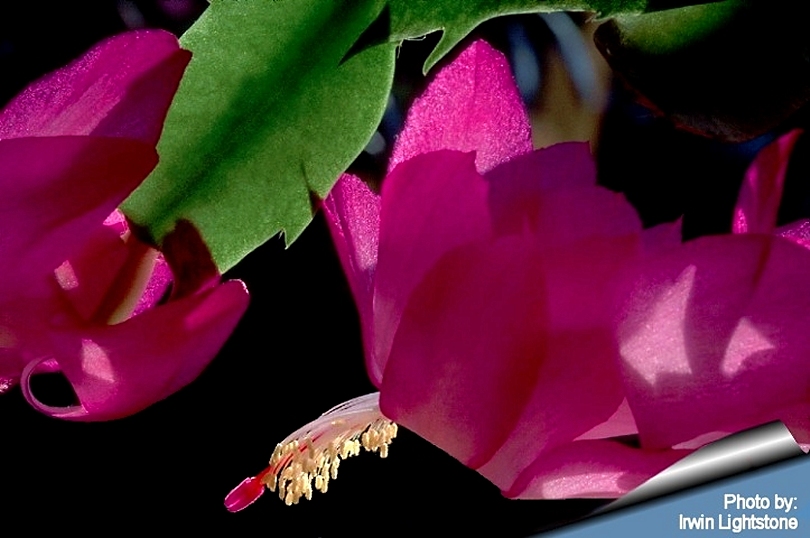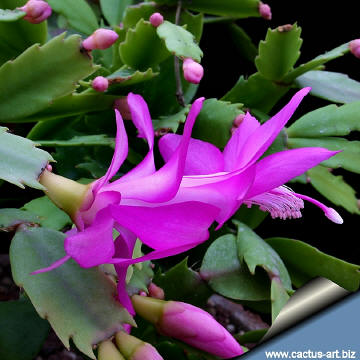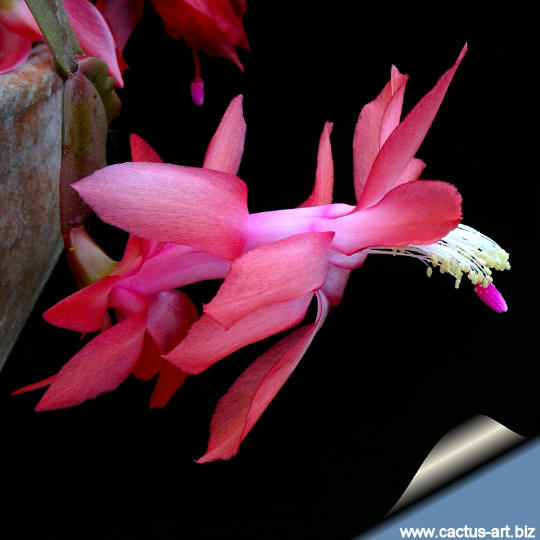|
|
|

Photo &
©
copyright
by
Irwin Lightstone
Schlumbergera are soft stemmed & spineless cactus which blooms very profusely.
|
|
 |
Description:
Branching cascading epiphyte,
with flattened joints. Height: 30 cm before weeping. Width: 30-45cm. The
individual stem joints form arching, pendulous branches from whose tips
hang satiny, many-petaled flowers.
Cladodes: Approx. 4.5 cm long, 2.5 cm broad, flattened leaf-like
dark and glossy green with two teeth at the apex. and small 2-8 toothed
(pointed), marginal notches,
Areoles: Almost spineless or with tiny brush-like spines and little
felt. Terminal areole long and felty.
Flower:
Zygomorphic, hooded, tubular 7-12 cm long, 4.5 cm red, pink,
purple, or multicolored. Style purple. Ovary round. Receptacle 4 cm
long. Blossoms at the stem joints as well as at the stem ends.
Blooming Period: From November through February. Flowering is triggered
by short days and cool temperatures
Fruit: round, red.
|
Zygocactus hybrids (Christmas cactus): These hybrids, often
cultivated as a houseplant, with their rather unique flower arrangement,
have been in cultivation since early in the 1800s and have had surges of
popularity. The term Zygocactus is the name predominant in the plant
industry despite what the taxonomists have decreed are now Schlumbergera.
There are many garden varieties, most of which are very beautiful. The
greenhouse cultivars has salmon, orange, peach, coral, yellow, white
pink or multicoloured flowers.
Cultivation: Like the Poinsettia, it takes very little effort to
get your Christmas cactus to flower at the right time. It requires ample
summer water and partial shade, but allow soil to dry slightly between waterings;
The Christmas cactus is a short day bloomer. Remember that the
shortening days of September and October are what trigger the flowering
cycle. Allow also temperatures at night to drop slightly to induce
flowering. During the flowering cycle, keep your Christmas cactus moist
(but not soggy). After the blossoms have fallen off you should back off on the
water for a couple of months. If it needs repotting, this is the time to
do it. Christmas cacti won't want a normal cactus soil but will
prefer to be in a soil containing sphagnum. This type of soil would
normally be used for orchids, bromeliads or other epiphytic plants. The
Shlumbergera drop their buds easily if they are moved. Once
flower buds have formed, DO NOT MOVE the plant, as slight changes in
environment may cause the buds to drop. These forest cacti tend to be
long lived.
Propagation: Stem cuttings, Grafting (For grafting this plant
Acanthocereus pentagonus is a good stock)


|
|
Advertising
|
|
|
|
|
Family:
Cactaceae (Cactus
Family) |
|
Scientific name:
Schlumbergera truncata (Haw) Moran
in: Gentes Herb. 8(4):329 (1953)
Origin: Brazil, Rio de Janeiro (Serra do Mar and Serra dos Org„os),
Habitat
& ecology: Native to the coastal forests and jungles at an
altitude of 100-1500 m. In its native environment it is an epiphyte
(occasionally lithophytic). In other words, these are cacti that grow in
trees! They grow their roots into the bark of their host tree. Their
only access to moisture and nutrients is from rain and droppings that
fall from above. They also always grow under a canopy of trees and are
never exposed to the full sun of the desert. The environment that these
cacti have adapted to is that of the warm, humid jungle with sunlight
filtered through the canopy of the forest. Little has been written of
the variability of colour in the flower in the wild although one would
assume that red predominates. The shape of the flowers suggests humming
bird pollination and red is attractive to birds. The berry is mostly red
attracting other birds to spread the seed to other areas.
Conservation status: Listed in
CITES appendix 2.
Common Names include: Christmas Cactus, Thanksgiving Cactus or
Crab Cactus,Zygocactus.
|
|
|
 |
Synonyms:
- Epiphyllum truncatum Haw
Supp. Pl. Succ. 85 (1819)
- Cactus truncatus Lk
Enum. Pl. 2:24 (1822)
- Cereus truncatus DC Sweet
Hort. Brit. 272 (1826)
- Epiphyllum altensteinii Pfeiff
Enum. Cact. 128 (1837)
- Epiphyllum truncatum altensteinii
Lem
Cact. Gen. Nov. Spec. 76 (1839)
- Epiphyllum purpurascens Lem
Hort. Univ. 2:349 (1841)
- Epiphyllum truncatum violaceum Morren
Belg. Hort. 16:260 (1866)
- Epiphyllum truncatum spectabile Morren
Belg. Hort. 16:260 (1866)
- Zygocactus truncatus K.Sch.
Flora Bras. 4(2): 224 (1890)
- Zygocactus altensteinii K. Sch.
Flora Bras. 4(2): 225 (1890)
- Epiphyllum delicatum N.E.Brown
Gard. Chron. III 32: 411 (1902)
- Epiphyllum delicatulum K.Sch.
Monatschr. Kakt. 13:9 (1903)
- Zygocactus delicatus Br&R
Contr. US Nat. Herb. 16:260 (1913)
- Zygocactus truncatus delicatus (N.E.Brown) Backbg & Knuth (1935)
- Zygocactus truncatus crenatus - Borg
Cacti ed. 2, 420 (1951)
- Schlumbergera truncata altensteinii (Pfeiff) Moran
Gent. Herb. 8(4):330
(1953)
- Schlumbergera truncata delicata (N.E.Brown) Moran
Gent. Herb. 8(4):330
(1953)a
|
|